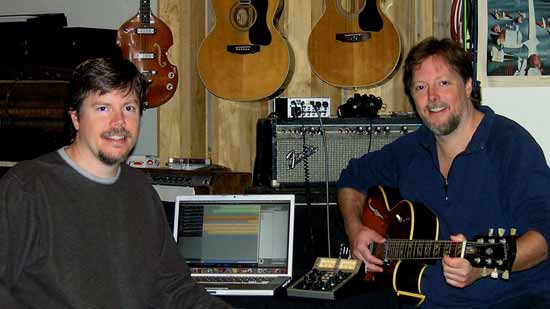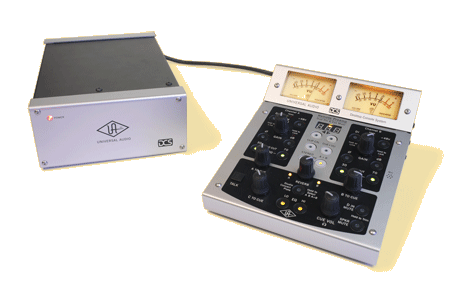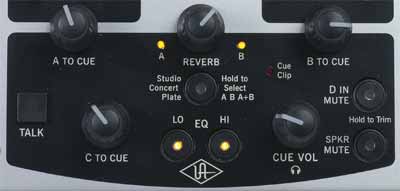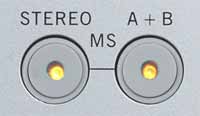Artist Interview: Product Consultant Scott Silfvast
By Marsha Vdovin
I recently sat down with UA's new Product Consultant, Scott Silfvast, who worked with UA to develop the forthcoming DCS System. Universal Audio is very excited to work with him on this new system that brings Class A Console-sound to the desktop.
 |
|
Rob and Scott Silfvast
|
Tell us about the DCS.
DCS is a series of products that are being launched as Universal Audio's "Desktop Console System." Each product provides a unique solution for the DAW-based studio that helps to interface the analog part of the studio (humans, mics, instruments, headphones, speakers, etc.) with the computer. The signal paths are world-class analog and are manipulated from a remote control that looks like a mini console with high-quality VU meters, knobs and switches. The remotes can live in places that have usually been tough for analog gear, like on the desktop between the computer display and QWERTY keyboard, or on a grand piano or a guitar player's amp. The separate audio "base units" contain all the jacks, audio and power-supply electronics in compact steel boxes, which can be close to signal sources-without needing to be reachable and without the problem of bringing a rat's nest of cables onto the desktop.
The first product is the DCS Remote Preamp, which helps recording artists hook into any workstation and get a live experience like they'd have in an expensive console-based studio. It's a two-way device designed to transparently amplify mono or stereo mics and instruments from the performer to the workstation. It also has a built-in cue mixer for creating and folding back an inspiring monitor mix, complete with "more me," self-reverb and headphone EQ.
“The DCS Monitor Master . . . makes working from the desktop feel like you are at the helm of a professional console.”
The next product is a full-featured speaker and cue controller called the DCS Monitor Master. It starts with a reference-grade DAC so the user doesn't need to rely on the unknown sonics of D/A converters in various interfaces and can monitor with confidence using the optical digital out from an Apple MacBook Pro or any of the many cost-effective USB or FireWire interfaces. Then it has all the basic features you would normally find on a pro studio console that switch several digital or analog sources to multiple sets of monitors for the engineer and recording artists.
 |
|
DCS Remote Preamp
|
The DCS products are designed to work together, with all mainstream audio interfaces, and to fit into the desktop computer-keyboard-and-screen environment.
Tell us about your background in the Audio Industry.
In 1988, back at the peak of the console/multitrack/outboard-rack-studio era, I started Euphonix with the notion of embedding digital control into consoles-attempting to eliminate all of the manual mixing, recalling and patching nightmares that used to be the biggest buzz-kill in any studio. We helped our customers create a recording process that was a lot like the ProTools process today but with analog audio for the most part, and eventually with a 96k digital engine and recorder by the end of the millennium. In 2001, after 13 years of intense development, I decided to get back to music for a while and took a break from the console business. Strangely, after a couple of years of musical experimentation in my basement studio, a new batch of recording hassles started popping up that I couldn't seem to make go away with existing products. The old console-design gears started turning. After several prototypes, the DCS stuff naturally emerged.
 |
|
DCS Remote Preamp headphone section
|
Stealth. In other words, you don't know it's there. It's the third option now in the UA line, which already offers the best money can buy when it comes to "classic tube" or "precision class A." We felt there was a need for a third type of mic pre that you could transparently amplify and pass signal from mic or instrument to the DSP where the sonic signature could then be created from a clean slate. We explored several different preamp architectures and found the transimpedance method achieved our goals with the greatest success. So that's how we approached the DCS preamp design, and after a wide range of listening tests it's proving its value in the audio universe.
What pro features are you most proud of including?
There are a few ways of working that experienced pros have come to expect in high-end studios, but haven't really made their way across the economic divide into the budget-conscious project studio.
For example, the DCS Remote Preamp makes it easy to give the artist a headphone mix that has reverb on the vocal or an instrument with EQ compensation-while allowing artists to control all the critical elements of their monitor mix from a portable remote.
Another favorite is the DCS Remote Preamp's ability to encode and monitor M-S stereo signals created from a good mono mic paired with a figure-8 mic. Although the pioneers of recording in the '50s and '60s often relied on M-S stereo for vocal and instrument recording, it seems this method has become a lost-in-cost art that is just waiting to be rediscovered.
Also, the DCS Remote Preamp sports a set of excellent low-cut filters that are tuned for vocals, guitar and bass that save the need for plug-in filters later on in the production process. Good filters are essential tools that veteran engineers rely on but haven't been accessible in the desktop studio.
 |
|
Record mid-side signals, while listening to the decoded result
|
Are you working with your brother again?
Of course! Rob and I worked together to develop all of the Euphonix digitally controlled analog consoles and the System 5 digital console. We have many years of experience together in that process. We've both been playing in bands and working with audio gear since before high school and are still at it today. The idea of working on products that could benefit "everyday" project studios, including our own, was exciting right from the start. Implementing world-class audio performance, functionality and build quality while also making sure the products were able to be sold at these breakthrough prices has been as challenging as any project we've ever worked on.
How did your partnership with UA come about?
Rob and I have known Bill Putnam Jr. since the late '90s when he started Universal Audio and Kind of Loud-we've been fans ever since. [UA's] reverence for classic analog and passion for state-of-the-art digital technology closely parallels our careers in the audio business. They were thinking about ways to streamline the desktop recording experience for their growing base of UAD-1 customers right around the same time we were working on product concepts. After a few meetings, we all realized there was great potential for a partnership and have been moving forward on the Desktop Console System ever since.